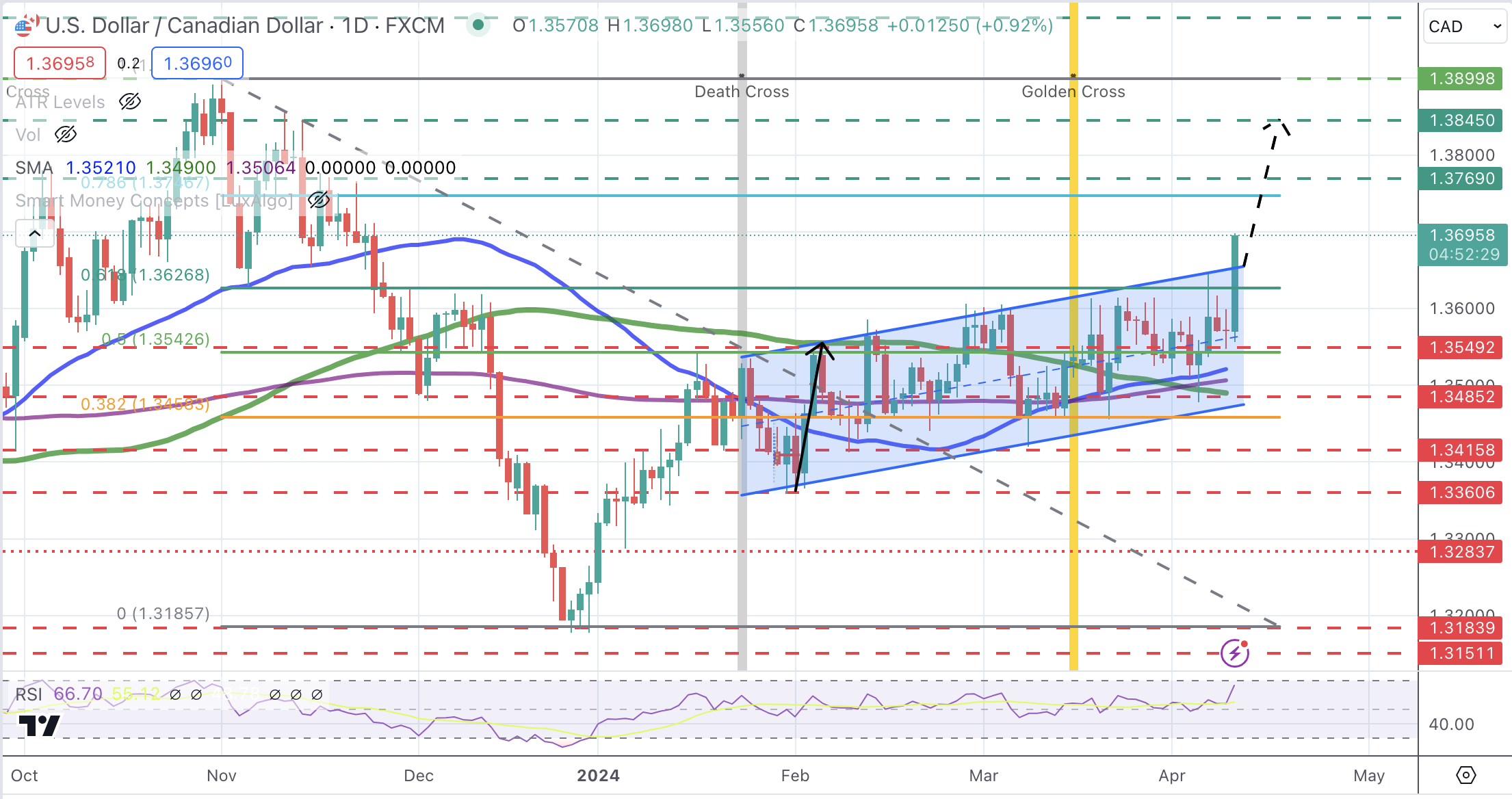- Canadian Dollar dives as US Dollar rallies after strong US CPI data.
- Bank of Canada keeps rates on hold but hints at rate cut, probably in June.
- Bets on Fed cut in June drop from 50% to 17% following US inflation figures.
The Canadian Dollar (CAD) has tumbled nearly 0.8% in Wednesday’s early North American session to reach the lowest levels this year so far. US Consumer Prices Index (CPI) figures for March confirmed that inflation remains stubbornly high, sending US Treasury yields and the US Dollar to fresh multi-month highs.
Price pressure remains sticky at levels well above the Federal Reserve’s (Fed) 2% core inflation target as last week’s strong employment and steady price growth data suggested. These figures back the Fed’s hawkish side and practically ditch its plan for three rate cuts, which was devised in January. This is expected to underpin the US Dollar in the near term.
In Canada, the Bank of Canada (BoC) kept interest rates unchanged, as widely expected, but noted a downward trend in core inflation. The market has observed those comments as a hint toward a rate cut in June, which has increased downside pressure on the CAD.
Daily digest market movers: USD/CAD rallies as US CPI figures cast doubt on Fed cuts
- Canadian Dollar trades at five-month lows, weighed down by strong US CPI data and dovish-tilted BoC statement.
- US headline inflation rises at 0.4% pace in March against market expectations of 0.3% increase. The YoY rate accelerates to 3.5% from 3.2% in February.
- Core CPI shows similar picture with 0.4% monthly increase, above market consensus of 0.3%, with the yearly rate steady at 3.8%.
- The Fed minutes show a hawkish edge with some policymakers concerned that financial conditions might not be sufficiently restrictive.
- Treasury yields for the US 10-year note reach key 4.5% level for first time this year. The 2-year yield jumped 25 basis points to hit levels right below 5%.
- Bets for Fed cut in June have plunged from about 50% to 17% following the release of US COPI data, according to CME Group FedWatch Tool.
- BoC left interest rates unchanged at 5%, but Governor Macklem revealed that the committee discussed the possibility of cutting rates.
Canadian Dollar price today
The table below shows the percentage change of Canadian Dollar (CAD) against listed major currencies today. Canadian Dollar was the strongest against the Australian Dollar.
| USD | EUR | GBP | CAD | AUD | JPY | NZD | CHF | |
| USD | 1.00% | 1.04% | 0.77% | 1.76% | 0.66% | 1.37% | 1.01% | |
| EUR | -1.01% | 0.04% | -0.20% | 0.78% | -0.33% | 0.37% | 0.03% | |
| GBP | -1.02% | -0.02% | -0.23% | 0.75% | -0.36% | 0.36% | 0.01% | |
| CAD | -0.77% | 0.23% | 0.29% | 1.00% | -0.10% | 0.63% | 0.25% | |
| AUD | -1.79% | -0.78% | -0.69% | -0.98% | -1.11% | -0.40% | -0.74% | |
| JPY | -0.66% | 0.34% | 0.39% | 0.12% | 1.10% | 0.72% | 0.36% | |
| NZD | -1.44% | -0.43% | -0.42% | -0.64% | 0.34% | -0.77% | -0.41% | |
| CHF | -1.02% | 0.00% | 0.04% | -0.25% | 0.76% | -0.35% | 0.38% |
The heat map shows percentage changes of major currencies against each other. The base currency is picked from the left column, while the quote currency is picked from the top row. For example, if you pick the Euro from the left column and move along the horizontal line to the Japanese Yen, the percentage change displayed in the box will represent EUR (base)/JPY (quote).
Technical analysis: USD/CAD breaks above channel top, next resistance at 1.3740
The US Dollar has broken above the last two months’ channel top as the strong US inflation data dampened hopes of a rate cut in June. Bulls have taken control, sending the pair to levels near 1.3700 so far.
The Relative Strength Index (RSI) is nearing overbought levels, which may lead to some correction. In that case, the reverse trendline might provide support on the path toward the 78.6% Fibonacci retracement at 1.3740 and 1.3770. The measured target of the broken channel is the mid-November high at 1.3845. Supports are the mentioned channel top, at 1.3650 and 1.3545.
USD/CAD Daily Chart

Canadian Dollar FAQs
The key factors driving the Canadian Dollar (CAD) are the level of interest rates set by the Bank of Canada (BoC), the price of Oil, Canada’s largest export, the health of its economy, inflation and the Trade Balance, which is the difference between the value of Canada’s exports versus its imports. Other factors include market sentiment – whether investors are taking on more risky assets (risk-on) or seeking safe-havens (risk-off) – with risk-on being CAD-positive. As its largest trading partner, the health of the US economy is also a key factor influencing the Canadian Dollar.
The Bank of Canada (BoC) has a significant influence on the Canadian Dollar by setting the level of interest rates that banks can lend to one another. This influences the level of interest rates for everyone. The main goal of the BoC is to maintain inflation at 1-3% by adjusting interest rates up or down. Relatively higher interest rates tend to be positive for the CAD. The Bank of Canada can also use quantitative easing and tightening to influence credit conditions, with the former CAD-negative and the latter CAD-positive.
The price of Oil is a key factor impacting the value of the Canadian Dollar. Petroleum is Canada’s biggest export, so Oil price tends to have an immediate impact on the CAD value. Generally, if Oil price rises CAD also goes up, as aggregate demand for the currency increases. The opposite is the case if the price of Oil falls. Higher Oil prices also tend to result in a greater likelihood of a positive Trade Balance, which is also supportive of the CAD.
While inflation had always traditionally been thought of as a negative factor for a currency since it lowers the value of money, the opposite has actually been the case in modern times with the relaxation of cross-border capital controls. Higher inflation tends to lead central banks to put up interest rates which attracts more capital inflows from global investors seeking a lucrative place to keep their money. This increases demand for the local currency, which in Canada’s case is the Canadian Dollar.
Macroeconomic data releases gauge the health of the economy and can have an impact on the Canadian Dollar. Indicators such as GDP, Manufacturing and Services PMIs, employment, and consumer sentiment surveys can all influence the direction of the CAD. A strong economy is good for the Canadian Dollar. Not only does it attract more foreign investment but it may encourage the Bank of Canada to put up interest rates, leading to a stronger currency. If economic data is weak, however, the CAD is likely to fall.
Information on these pages contains forward-looking statements that involve risks and uncertainties. Markets and instruments profiled on this page are for informational purposes only and should not in any way come across as a recommendation to buy or sell in these assets. You should do your own thorough research before making any investment decisions. FXStreet does not in any way guarantee that this information is free from mistakes, errors, or material misstatements. It also does not guarantee that this information is of a timely nature. Investing in Open Markets involves a great deal of risk, including the loss of all or a portion of your investment, as well as emotional distress. All risks, losses and costs associated with investing, including total loss of principal, are your responsibility. The views and opinions expressed in this article are those of the authors and do not necessarily reflect the official policy or position of FXStreet nor its advertisers. The author will not be held responsible for information that is found at the end of links posted on this page.
If not otherwise explicitly mentioned in the body of the article, at the time of writing, the author has no position in any stock mentioned in this article and no business relationship with any company mentioned. The author has not received compensation for writing this article, other than from FXStreet.
FXStreet and the author do not provide personalized recommendations. The author makes no representations as to the accuracy, completeness, or suitability of this information. FXStreet and the author will not be liable for any errors, omissions or any losses, injuries or damages arising from this information and its display or use. Errors and omissions excepted.
The author and FXStreet are not registered investment advisors and nothing in this article is intended to be investment advice.
Recommended content
Editors’ Picks

EUR/USD stabilizes around 1.2550 after hitting two-year lows
EUR/USD plunged to 1.0223, its lowest in over two years, as risk aversion fueled demand for the US Dollar. Thin post-holiday trading exacerbated the movements, with financial markets slowly returning to normal.

USD/JPY flirts with multi-month highs in the 158.00 region
The USD/JPY pair traded as high as 157.84 on Thursday, nearing the December multi-month high of 158.07. Additional gains are on the docket amid prevalent risk aversion.

Gold retains the $2,650 level as Asian traders reach their desks
Gold gathered recovery momentum and hit a two-week-high at $2,660 in the American session on Thursday. The precious metal benefits from the sour market mood and looks poised to extend its advance ahead of the weekly close.

These 5 altcoins are rallying ahead of $16 billion FTX creditor payout
FTX begins creditor payouts on January 3, in agreement with BitGo and Kraken, per an official announcement. Bonk, Fantom, Jupiter, Raydium and Solana are rallying on Thursday, before FTX repayment begins.

Three Fundamentals: Year-end flows, Jobless Claims and ISM Manufacturing PMI stand out Premium
Money managers may adjust their portfolios ahead of the year-end. Weekly US Jobless Claims serve as the first meaningful release in 2025. The ISM Manufacturing PMI provides an initial indication ahead of Nonfarm Payrolls.

Best Forex Brokers with Low Spreads
VERIFIED Low spreads are crucial for reducing trading costs. Explore top Forex brokers offering competitive spreads and high leverage. Compare options for EUR/USD, GBP/USD, USD/JPY, and Gold.